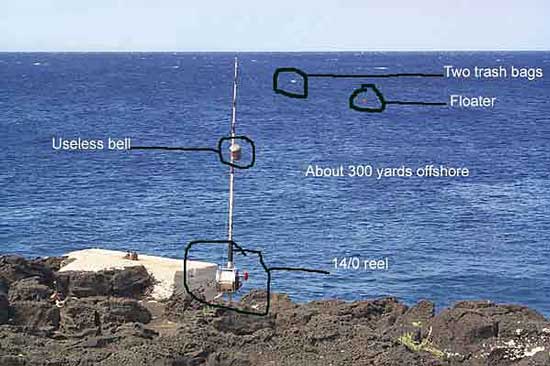While people use the plastic trash bags because they are cheap and easy to get, they have some serious drawbacks. The main disadvantage of the trash bags is that since they are in the water, the fishing line they are attached to and the inflated bag
are both very affected by the currents. This causes a lot of uncontrollable drift.
The kite on the other hand eliminates both these sources of drift and helps to keep the bait better positioned.
The kite also gives a lot more control over the direction and positioning of the fish bait when the wind is not quite right.
Another huge bonus is that the weight of the float can be adjusted so that the bait rises and falls in wind gusts and this movement seems to attract more fish.
Finally, on days when the wind is light, the flexiwing kite can get the bait out much faster than the trash bags. This keeps the bait away from the smaller reef fish which are too small to be caught but will eat all of the bait before it gets out beyond
the shallow reef. The bait must get beyond the drop off to be out where the big game fish are patrolling.
Of course, anyone using Paul's Flexiwing Kites already knows all of these advantages.

The photo above shows the area that we fish regularly and the rig that I used before using the kite. Except for the useless bell and two trash bags, the rig is the same as that I use now. The useless bell has been replaced with a more effective
electronic alarm to signal when a fish is on, and most importantly, the trash bags are now replaced with a flexiwing kite flying above the float. Note the concrete block and rod holder

The Rig
The fishing rig we use is a single dropper connected under a kite. The kite is flown from a large capacity reel, our smallest rig is a 9/0 Penn Senator fishing reel fitted to a stand up boat rod and our biggest is a 14/0 Penn Senator on a heavy duty
stand up rod. The dropper line carries a single baited circle hook on the end and a one litre float is attached anywhere up to 10 meters above the hook. Other popular styles for fishing over a variety of bottom types see kite
fishing rig designs .
Land Based Game Fishing With Kites in New Zealand
Obviously, not everyone would want to fish from a ledge a hundred feet or more above sea level, the good news is that in New Zealand you shouldn't have to!
To date we have received three New Zealand fishing reports of marlin being hooked from the shore on kite rigs set for snapper. It comes as no surprise that none of the marlin were landed as a snapper hook and trace is simply not up to the job.
Some years ago a yellow fin tuna of around 20kg was reported landed at Doubtless Bay from a kite longline baited with pilchards and set mid-water.
All of these gamefish were hooked from the beach and this makes them very easy to target with kites.
Just imagine, Alberts rig above, baited with a live kahawai. Simply run the bait out under a flexiwing kite to 1500 to 2000 meters offshore from a Penn 12/0 or 14/0 reel spooled with 130 lb B/S spectra.
Then stick the heavy duty rod in a rod holder on the front of the 4WD and drive slowly up and down the beach. The burley or fish oil you put in, or on, the float bottle would seep out and leave a scent trail a mile or more offshore, and it would be
as long as the distance you drive up the beach.
No self respecting gamefish could resist it. After you have caught a few with this simple rig, then would be the time to see if it could be done while complying with IGFA rules.
Remember, Edmund Hillary climbed Everest with the help of oxygen and Sherpas. Many have done it since with only one or none of these aids, but it is Hillarys' name we all remember because he done it first!
Who will catch the first land-based marlin in New Zealand?
|